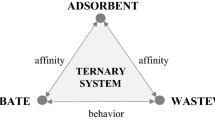Abstract
The extraction and separation of Fe(III) from heavy metal wastewater generated in zinc smelting process were studied using solvent impregnated resin containing CL-P204. The influence of pH and temperature on absorbing heavy metal cations by static adsorption was investigated. The batch tests on adsorption equilibrium, kinetics and elution efficiency were carried out to evaluate the performance of CL-P204. Column operations for extraction and separation of Fe(III) by CL-P204 were performed for further optimization of process parameters and feasibility evaluation. The reaction mechanism of Fe(III) and CL-P204 was analyzed through saturation capability, slope analysis and infrared spectroscopy (IR). The results show that the separation of Fe(III) from heavy metal wastewater using CL-P204 can be achieved through process of adsorption and desorption at a flow rate of 1.53 ml·min−1·cm−2, pH 0.8 and temperature of 25 °C. The experimental data of Fe(III) adsorption by CL-P204 have a satisfactory fit with Langmuir adsorption equation and Freundlich adsorption isotherms. The probable molecular formula of extracted complex is Fe[R2(R2H)], and the adsorption reaction equation is concluded as following: \({\text{Fe}}^{3 + } + 4{\text{RH}}\mathop \Leftrightarrow \limits^{{K_{\text{ex}} }} {\text{Fe}}[{\text{R}}_{2} ({\text{R}}_{2} {\text{H}})] + 3{\text{H}}^{ + } \) (K ex, extraction equilibrium constant). This study will supply the fundamentals for treatment of heavy metal wastewater.












Similar content being viewed by others
References
Visa M, Chelaru AM. Hydrothermally modified fly ash for heavy metals and dyes removal in advanced wastewater treatment. Appl Surf Sci. 2014;303:14.
Yu P, Ren YM, Zhang ML. The researchful progress on treatment techniques of heavy metals water. Environ Scie Manag. 2006;3(7):103.
Tan S, Xu D, Dong L, Wei S, Luo Z, Zhang H. Solvent extraction of butyl acetate from lovastatin wastewater using liquid paraffin. Desalination. 2012;286:94.
Shen S. Solvent extraction separation of tyramine from simulated alkaloid processing wastewater by cyanex 923/kerosene. Sep Purif Technol. 2013;103:28.
Kalidhasan S, Rajesh N. Simple and selective extraction process for chromium(VI) in industrial wastewater. J Hazard Mater. 2009;170(2):1079.
Wang JD, Chen JY. Solvent Extraction Manual. Beijing: Chemical Industry Press; 2001. 485.
Ma RJ. Extraction Metallurgy. Beijing: Metallurgical Industry Press; 2009. 404.
Chen TZ, John D. Jarofix: addressing iron disposal in the zinc industry. J Miner Metals Mater Soc. 2001;53(12):32.
Zhu T. Extraction and Ion Exchange. Beijing: Metallurgical Industry Press; 2005. 454.
Warshawsky A. Impregnated resins for extraction of metals and processes of production and use thereof. US Patent 4220726; 1977.
Matsunaga H, Ismail AA, Wakui Y, Yokoyama T. Extraction of rare earth elements with 2-ethylhexyl hydrogen 2-ethylhexyl phosphonate impregnated resins having different morphology and reagent content. React Funct Polym. 2001;49(3):189.
Nakamura T, Ikawa T, Nishihama S, Yoshizuka K. Selective recovery of indium from acid sulfate media with solvent impregnated resin of bis (4-cyclohexylcyclohexyl) phosphoric acid as an extractant. Ion Exch Lett. 2009;2:22.
Helaly OS, Abd El-Ghany MS, Moustafa MI, Abuzaidl AH, Abd El-Monem NM, Ismail IM. Extraction of cerium(IV) using tributyl phosphate impregnated resin from nitric acid medium. Trans Nonferrous Met Soc China. 2012;22(1):206.
Khaldun I, Buchari Sulaeman A, Bachri Amran M. Separation of La(III), Ce(III), Pr(III) and Nd(III) using solvent impregnated resin (SIR). In: Proceedings of the International Conference on Chemical Sciences. Indonesia; 2007. 24.
Cortina JL, Warshawsky A. Developments in solid-liquid extraction by solvent-impregnated resins. Ion Exchange and Solvent Extraction. 1997;28(52):195.
Saha B, Gilla RJ, Baileya DG. Separation of Cr[VI] from aqueous solution by Amberlite XAD-7 resin impregnated with Aliquat 336. React Funct Polym. 2004;60:223.
Benamor M, Bouariche Z, Belaid T. Kinetic studies on cadmium ions by Amberlite XAD-7 impregnated resins containing di(2-ethylhexyl) phosphoric acid as extractant. Sep Purif Technol. 2008;59(1):74.
Berdous D, Akretche DE. Recovery of heavy metals using solvent impregnated resin (SIR) coupled with donnan dialysis. Mater Sci Appl. 2012;3(10):704.
Sun H, Zhang L, Xu ZG, Yin YX, Lang SL, Wang LJ. Preparation of high purity FeCl3 solution by P204 solvent impregnated resin. Hydrometall China. 2009;28(3):173.
Nishihama S, Kohata K, Yoshizuka K. Separation of lanthanum and cerium using a coated solvent-impregnated resin. Sep Purif Technol. 2013;118:511.
Kabay N, Arda M, Trochirnczuk A. Removal of chromate by solvent impregnated resins (SIRs) stabilized by coating and chemical crosslinking. II. Column-mode sorption/elution studies. React Funct Polym. 2004;59(1):15.
Wang ST, Tan DS, Liu SZ. Study and application on solvent impregnated resins technique in separation of nonferrous metals. China Nonferrous Metall. 2008;1:27.
Qiu YX. The synergistic extraction and separation of copper, nickel, cobalt, zinc, and cadmium from wastewater by Versatic10/Mextral984H system. Beijing: General Research Institute for Nonferrous Metals; 2004. 1.
Ying WJ, Ya WH, Shen YY, Wang NY, Zhang J. Separation of rare earth by CL-P204 resins. Rare Earths. 1981;6:1.
Dong SM, Zhang LP. Study on the adsorption extraction of germanium with CL-N235 extraction resin. Rare Metals Cemented Carbides. 2006;34(3):1.
Liu JS, Yuan YX. Adsorption property of P507 levextrel resin for indium(III) from hydrochloric acid system. Rare Metals Cemented Carbides. 2008;36(4):1.
Liu JJ, Zhou BX, Cai WM. Study on adsorption properties and mechanism of gallium by D2EHPA levextrel resin. Ion Exch Adsorpt. 2002;18(3):267.
Fouad EA. Separation of copper from aqueous sulfate solution by mixtures of Cyanex301 and LIX 984N. J Hazard Mater. 2009;166(2–3):720.
Acknowledgments
This study was financially supported by the International S&T Cooperation Program of China (ISTCP) (No. 2014DFA90920).
Author information
Authors and Affiliations
Corresponding author
Rights and permissions
About this article
Cite this article
Sun, Q., Yang, LM., Zhang, L. et al. Extraction and separation of Fe(III) from heavy metal wastewater using P204 solvent impregnated resin. Rare Met. 37, 894–903 (2018). https://doi.org/10.1007/s12598-016-0729-0
Received:
Revised:
Accepted:
Published:
Issue Date:
DOI: https://doi.org/10.1007/s12598-016-0729-0




